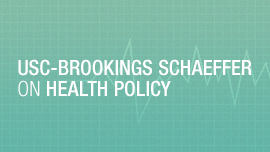This blog post is part of the USC-Brookings Schaeffer Initiative for Health Policy, which is a partnership between Economic Studies at Brookings and the University of Southern California Schaeffer Center for Health Policy & Economics. The Initiative aims to inform the national health care debate with rigorous, evidence-based analysis leading to practical recommendations using the collaborative strengths of USC and Brookings. We gratefully acknowledge support from the Robert Wood Johnson Foundation and the National Institute on Drug Abuse.
There is strong evidence that the opioid epidemic has reduced labor force participation in the United States. While use of prescription opioids aimed at pain management for some individuals may enhance their ability to work, the widespread misuse of opioids has resulted in an epidemic of opioid use disorders (OUD), labor supply disruptions, and unprecedented deaths. Opioid misuse can compromise labor supply in a variety of ways, including absenteeism, increased workplace accidents, and withdrawal from the labor force due to disability, incarceration, or death.
Overview of the issue
The opioid epidemic has been widely characterized as having three distinct waves of overdose deaths: the first wave beginning in the 1990s with increases in deaths involving prescription opioids; the second wave beginning in 2010 with increases in deaths involving heroin; and the third wave beginning in 2013 with increases in deaths involving synthetic opioids such as fentanyl. Several researchers have investigated the effects of elevated prescription opioid misuse, which began during the first wave of the epidemic, on labor supply. Though one study found small positive effects of prescription opioids on labor force participation for women, the majority of studies on this relationship have found that regions with higher exposure to opioid prescriptions experienced significant declines in labor force participation. In a 2016 survey of men aged 25-54 who were not in the labor force, nearly half of respondents reported taking pain medications on a daily basis, two-thirds of whom were taking prescription pain medications. In a follow-up survey of women in the same age group who were not in the labor force, 54% of respondents reported taking pain medications daily, half of whom were taking prescription medications.
The rise in illicit opioid use during the second and third waves of the opioid epidemic also reduced labor force participation, decreased employment, and increased applications for Social Security Disability Insurance (SSDI) and Supplemental Security Income (SSI). Incarceration for offenses related to illicit opioids likely also contributes to the decrease in labor force participation caused by the opioid epidemic.
Altogether, the effects of the opioid epidemic on labor force participation have been significant. One estimate suggests the opioid epidemic accounts for 43% of the decline in men’s labor force participation rate between 1999 and 2015, and 25% of the decline for women.
Beyond its effects on labor force participation, the opioid epidemic also has implications for the working population. An estimated 12.6% of the U.S. workforce receives an opioid prescription each year, and 75% of employers surveyed by the National Safety Council report that they have been directly affected by opioids. OUD can impact workers’ labor market outcomes: workers with substance use disorders take nearly 50% more days of unscheduled leave than other workers, have an average turnover rate 44% higher than that for the workforce as a whole, and are more likely to experience occupational injuries that result in time away from work.
While the opioid epidemic has had significant impacts across the labor market, its effects have been particularly pronounced in specific occupations and industries. A CDC analysis of mortality data from 21 states concluded that unintentional and undetermined overdose deaths accounted for a disproportionate share of all deaths in the following six occupational groups: construction, extraction (e.g., mining), food preparation and serving, health care practitioners, health care support, and personal care and service. These fatalities are particularly concentrated in construction and extraction: an analysis by the Massachusetts Department of Public Health found that individuals employed in construction and extraction accounted for over 24% of all overdose deaths in the state’s working population.
Notably, the jobs with the highest rates of opioid overdose fatalities generally have high occupational injury rates and low access to paid sick leave. Figure 1 demonstrates that the industries with the highest rates of overdose fatalities in the workplace have elevated occupational injury rates for fractures and musculoskeletal disorders, both of which are significant risk factors for long-term opioid use.

Occupational injuries often lead to opioid prescriptions. For example, a study of workers’ compensation claims from 2013-2015 in Tennessee found that, among previously opioid-free workers who were injured on the job, one-third had received an opioid prescription within six months of their occupational injury. Another national study of construction workers found that individuals with occupational injuries were nearly four times more likely to use prescription opioids than those without injuries. As such, work-related injury is a significant risk factor for OUD and its sequelae: one study of all opioid-related fatalities in Utah during 2008-2009 found that 57% of all decedents had experienced at least one prior occupational injury.
Employees with limited access to paid sick leave may also rely on opioids after an occupational injury in order to manage pain and continue working, making them more vulnerable to OUD. In the analysis completed by the Massachusetts Department of Public Health, the rate of opioid-related deaths was roughly four times higher in industries with low access to paid sick leave. In addition, the share of employees with access to paid sick leave is nearly 20% lower in industries with high workplace overdose fatality rates, compared to industries with low workplace overdose fatality rates (Figure 2). These links between occupational injury, employee benefits, and OUD suggest an important role for employers in primary prevention of OUD.

Employers have also been impacted by the opioid epidemic and its effects on the U.S. workforce. First, the decrease in labor force participation has reduced the pool of workers from which employers can hire, which is a particular concern given the tightness of the U.S. labor market in recent years. In addition, employees with OUD impose higher costs to their employers, particularly through health insurance and workers’ compensation. Approximately a third of working-age adults with OUD are covered by private insurance, which pays an estimated half of all opioid prescription costs for U.S. workers. While employer spending on opioid prescriptions peaked in 2009, overall OUD treatment costs have continued to increase: large employer plans spent $2.6 billion on OUD-related costs in 2016, over four times more than they spent in 2009. Employees with OUD may also incur higher workers’ compensation costs for employers. These direct costs, in addition to indirect costs incurred to employers through absenteeism, turnover, and lost productivity, are estimated to total in the thousands for each employee with OUD.
A recent study suggests that these opioid-related pressures on employers have had measurable impacts on firm behavior and performance. The authors compare firms in counties with higher growth in opioid use to those in counties with low growth in opioid use, controlling for their baseline characteristics. They find that, after the five-year study period, establishments in high-opioid growth counties employ fewer people and spend comparatively more on information technology. This suggests that firms might be substituting technology for employees when they are faced with labor shortages and higher per-employee costs induced by the opioid epidemic. This study also provides evidence that the opioid epidemic may negatively impact firm valuation: when state laws are introduced to reduce access to opioids, which might mitigate the negative impacts of the opioid epidemic, the authors observe an increase in employer firms’ stock prices in the relevant states.
Addressing the problem
The opioid epidemic can impact employers, but employers can also have an impact on the opioid epidemic. The evidence cited above highlights a potential business case to be made for employers both preventing OUD among their workers and supporting workers that are in active recovery from OUD. Additionally, the benefits of employment for individuals in recovery should not be understated. Work is a good predictor of positive outcomes for individuals with substance use disorder (SUD). Compared with individuals who are unemployed and in recovery from SUD, those who are employed are more likely to exhibit lower rates of recurrence, higher rates of abstinence, fewer parole violations, and improvements in quality of life. Moreover, there is evidence that employer-mandated treatment is as, if not more, successful than treatment mandated by friends or family.
However, despite the mutual benefit that work provides to employees and employers, many barriers to employment for people with OUD persist, including poor work history, lack of job skills, lower educational attainment, and scheduling conflicts with treatment programs.
Some individuals with OUD have a prior criminal history, and are thus impacted by the collateral consequences of conviction, which can include ineligibility for employment in health care facilities or within a state government or ineligibility to obtain a professional license in certain fields.
Employers may add to these existing barriers when they implement punitive and stigmatizing drug testing. These programs can not only lead to the firing of current employees but can deter people from applying to jobs in the first place. The consequences of this practice impact both employers and employees. For employers, firing an existing worker means having to hire and train a replacement or spending longer on a hiring process and possibly missing out on a strong candidate. For employees, this can often mean missing out on benefits of steady work, including the income and social supports that come with it.
Policies and programs to support recovery
Supporting individuals in recovery requires a “whole-of-society” approach. The private sector, public sector, health care sector, community organizations, and families all have a role to play. There are a number of policies and programs in place to support employment for individuals in recovery, though more can be done to support awareness, implementation, and evaluation.
Opioid use disorder prevention
Employers can play an important role in the upstream prevention of SUD among their employees. A number of tools and resources exist to support employers with substance misuse prevention—especially in industries with high rates of occupational injuries. Historically, opioids have been overprescribed in the workers’ compensation system. In recent years, many states have taken measures to both reduce the number of compensation claims with prescription opioids and decrease the average amount of opioids prescribed per workers’ compensation claim. However, opioid dispensing rates within workers’ compensation systems continue to vary by industry, company size, age of the injured worker, type of injury, and county-level factors. Employers can work closely with health insurers, workers’ compensation carriers, and pharmacy benefit managers to access utilization data and promote conservative prescribing guidelines for injured workers. By taking a proactive role, employers have the potential prevent OUD and overdose among their employees.
Recovery-friendly workplaces
As defined by the Department of Labor (DOL), “recovery-friendly workplaces are characterized by the adoption of policies and practices that:
- Expand employment opportunities for people in or seeking recovery;
- Inform employees in recovery that they may have the right to reasonable accommodations and other protections that can help them keep their jobs;
- Reduce the risk of substance use and substance use disorder, including through education and steps to prevent injury in the workplace;
- Facilitate help-seeking among employees with substance use disorder; and,
- Ensure access to needed services, including treatment, recovery support, and mutual aid.”
The Recovery-Ready Workforce Resource Hub includes federal resources, state resources, local resources, union and trade association resources, community-based recovery support resources for employers, and training for employers to implement policies in their own places of work.
Employment assistance programs (EAPs) can also be used to promote a recovery-friendly workplace. An EAP is designed to assist employees in resolving personal problems that may be negatively impacting their performance, including struggles with SUDs. However, while nearly 98% of mid-to-large companies offer EAPs, only 4% of employees use them each year. Low utilization is likely due to lack of awareness of programs offered, and stigma and confidentiality-related concerns about SUD. It is also unclear how widespread EAP availability is within industries with high rates of OUD like construction and mining—further data collection is needed to target strategies for uptake among these employees and industries.
The federal government incentivizes the hiring of individuals in recovery through the Department of Labor’s Federal Bonding Program, which provides fidelity bonds for “at-risk” and difficult-to-place job seekers. These bonds cover the first six months of employment at no cost to the job seeker or the employer. The DOL and the Office of National Drug Control Policy have also devoted resources to the promotion of Individual Placement and Support for individuals with OUD. Though this model has been traditionally used for job seekers with serious mental illness and developmental disabilities, there is emerging evidence of its effectiveness as an approach for people with SUD, although more research of this model is necessary. State governments in New York and Illinois have also created tax credits to incentivize employers to hire individuals in recovery. Within the business community, the U.S. Chamber of Commerce has promoted resources for second chance hiring programs.
Despite the availability of resources and incentives, the National Safety Council recently reported that 75% of surveyed employers have been impacted by prescription drug misuse, but fewer than 17% feel extremely prepared to deal with it. This demonstrates the importance of continued education and outreach to the business community to ensure they are supported in the endeavor of building recovery-friendly workplaces.
Conclusion
The effects of the opioid epidemic in the United States have been far-reaching, causing unprecedented deaths and long-term health impacts including OUD. This health crisis has also had implications for the U.S. economy, including disruptions to the labor force. Recent evidence demonstrates that employers have been adversely impacted by the opioid epidemic through workforce shortages, reduced employee productivity, and elevated personnel costs. In addition, workplace factors appear to impact the incidence of OUD among employees. As such, employers are well-positioned to help address the epidemic through efforts to reduce the use of opioids for pain management among their employees and support recovery among workers.
This piece was supported by the Robert Wood Johnson Foundation and the National Institute on Drug Abuse.
The Brookings Institution is financed through the support of a diverse array of foundations, corporations, governments, individuals, as well as an endowment. A list of donors can be found in our annual reports published online here. The findings, interpretations, and conclusions in this report are solely those of its author(s) and are not influenced by any donation.
-
Acknowledgements and disclosures
The authors would like to thank Joseph Hnath for his research assistance and Sherry Glied for providing comments on an earlier draft of the piece.
The Brookings Institution is committed to quality, independence, and impact.
We are supported by a diverse array of funders. In line with our values and policies, each Brookings publication represents the sole views of its author(s).







Commentary
The economic impact of the opioid epidemic
April 17, 2023